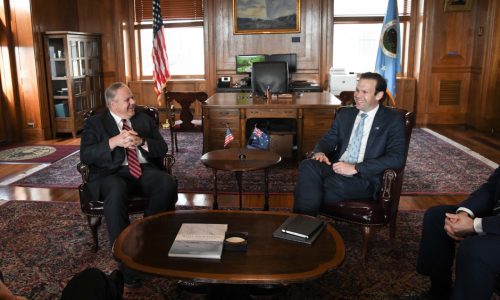
The United States and Australia have formalized their partnership on developing both nations’ critical mineral assets between Geoscience Australia CEO James Johnson and U.S. Geological Survey (USGS) Director Jim Reilly.
The two partners outlined specific steps to strengthen an existing Memorandum of Understanding by collaborating on research and increasing critical mineral capacity for both countries.
“We are working with our close international partners and allies to carry out President Trump’s blueprint to position the United States as a leader in the critical minerals sector and ensure economic prosperity,” said Secretary of the Interior David Bernhardt. “This is an important milestone in reducing the Nation’s susceptibility to critical mineral supply disruptions.”
Critical minerals are used in nearly all economic sectors for a range of products, including mobile phones, electronics, batteries, fiber optics, steelmaking, military gear and medical equipment.
The new activities focus on joint critical mineral potential mapping and quantitative mineral assessments; determining geological controls on critical mineral distribution; and developing data analytics capability to understand supply and demand scenarios for developing critical minerals trade between the two countries.
“Today’s commitment is an important next step in accomplishing the goals of the Trump Administration’s strategy to secure the supply of minerals critical to our national security and economic growth,” said Reilly. “We are grateful for the strong partnership we continue to enjoy with our Australian counterparts.”
“This is a partnership that will deliver opportunity and security to both nations,” said Minister for Resources and Northern Australia Matt Canavan. “Australia is in a position to develop stable supply chains to meet the growing global demand for critical minerals, especially in key economies such as the U.S. The U.S. has a need for critical minerals and Australia’s abundant supplies makes us a reliable international partner in securing access to a wide range of those including rare earth elements.”
These research priorities and international cooperation are both significant aspects of the Federal Strategy to Ensure a Reliable Supply of Critical Minerals, which the Trump Administration published in June of 2019. Among other things, the strategy directs the DOI to locate domestic supplies of those minerals, ensure access to information necessary for the study and production of minerals, and expedite permitting for minerals projects.
The strategy also directs the USGS to explore international partnerships with close allies and partners to learn more about how those countries study their critical minerals and what lessons the United States could take from them. The USGS has begun doing so with Australia, and a wide-ranging Memorandum of Understanding that was updated in 2018 has already been of great benefit.
For example, the USGS’s effort to collect new geophysical, geological and topographical data is modeled on, among other things, Australian investments in similar geoscience datasets.
Under Executive Order 13817 signed by President Trump, “critical minerals” are non-fuel mineral or mineral materials that are essential to the economic and national security of the United States, that have a supply chain vulnerable to disruption, and that serve an essential function in the manufacturing of a product, the absence of which would have significant consequences for the economy or national security.
In May of 2018, DOI released a list of 35 minerals deemed critical to the U.S. economy and security, based on a methodology by the USGS. This list forms the foundation of the full Federal strategy.


Bulloch Local News
Downtown Statesboro Welcomes WhipItUp Engraving Studio

Bulloch Public Safety
05/19/2025 Booking Report for Bulloch County

Chattooga Sports
Menlo 12U Tigers Crowned NCS Alabama State Champions

Chattooga Local News
Dade County Officer Arrested, Fired Amid Sexual Assault Investigation

Bulloch Public Safety
04/28/2025 Booking Report for Bulloch County

Bulloch Public Safety
05/02/2025 Booking Report for Bulloch County

Bulloch Public Safety
05/05/2025 Booking Report for Bulloch County

Bulloch Public Safety
04/21/2025 Booking Report for Bulloch County

Bulloch Public Safety
05/12/2025 Booking Report for Bulloch County






